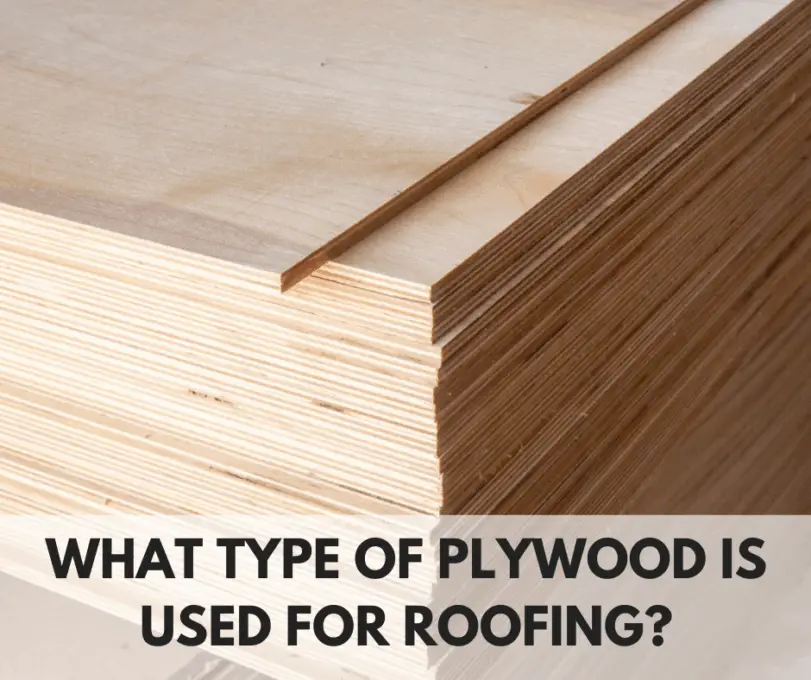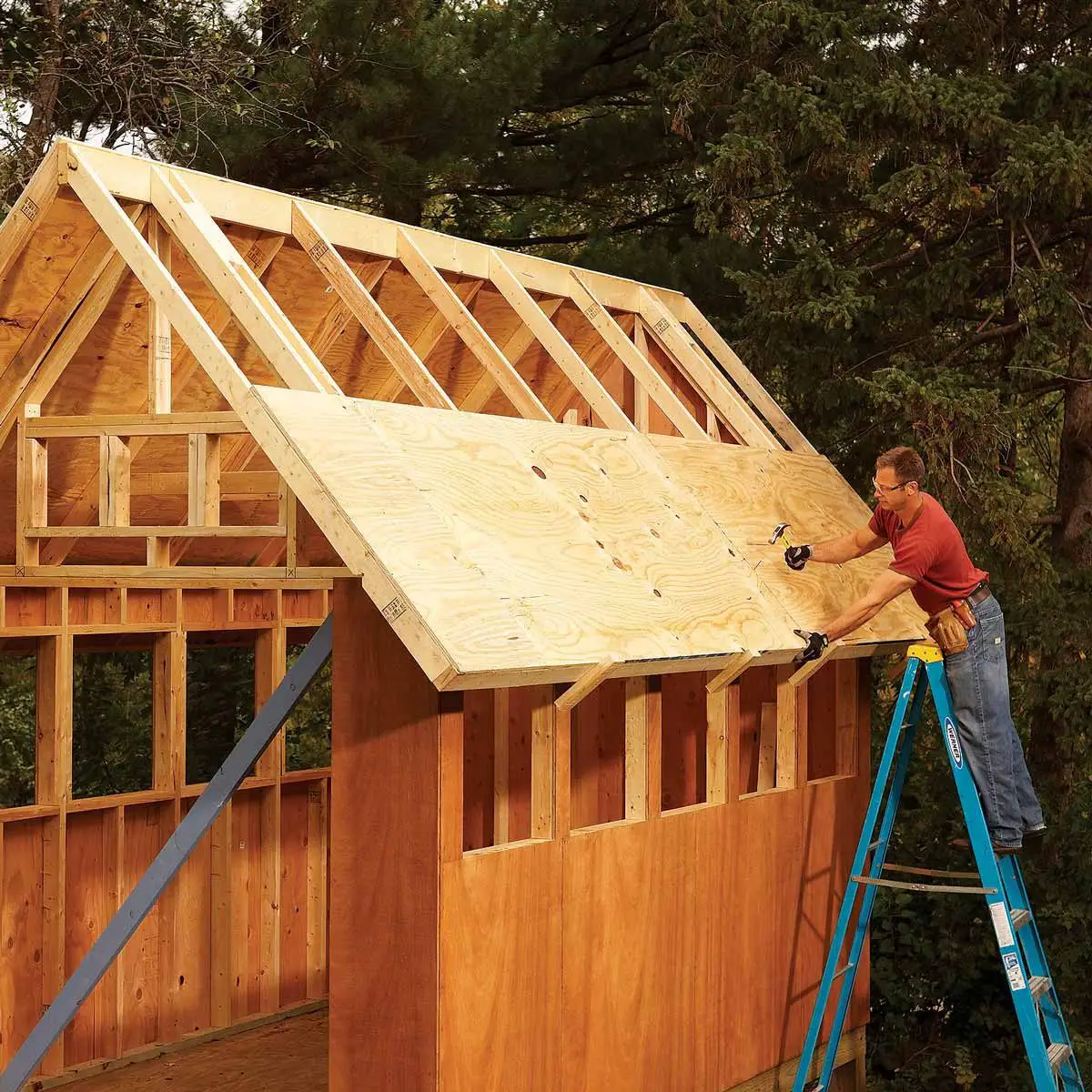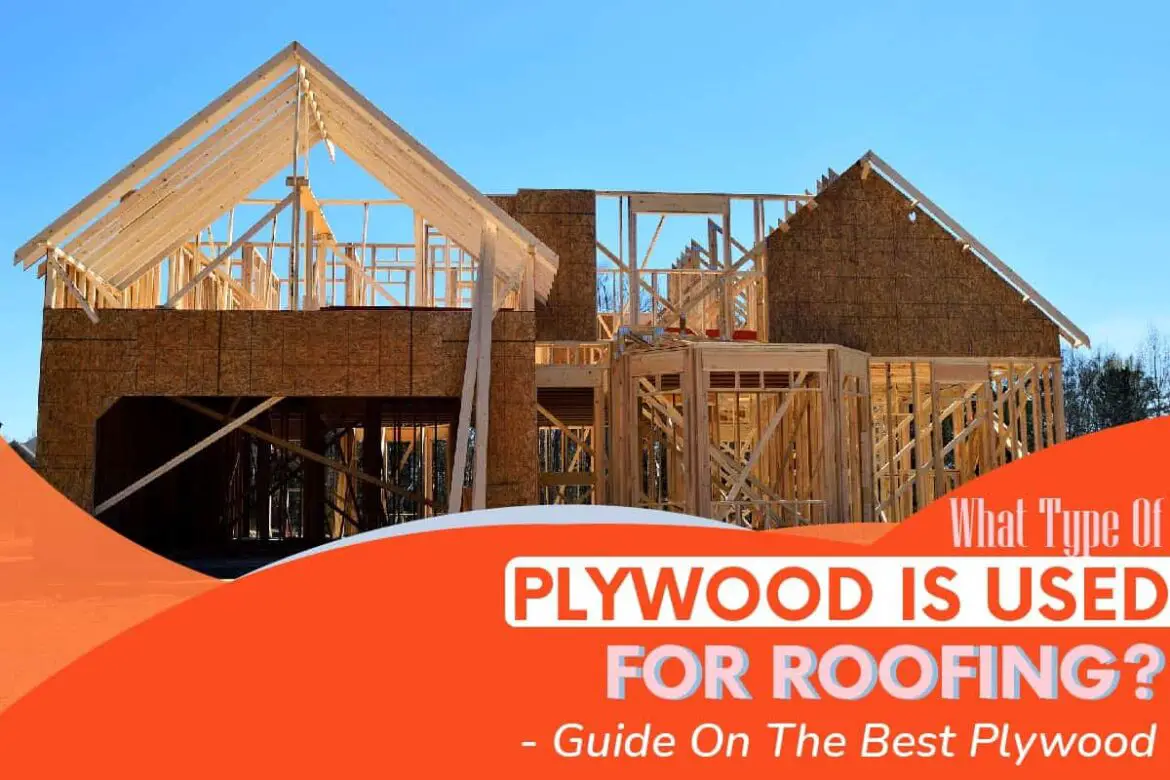What Size Plywood For Roofing
The most common rafter spacing is 24 inches. You can get plywood sheets with a length of up to 4 x 10 feet and OSB comes up to 16 feet long in length.
Do Most people ask how many sheets of plywood do I need for my roof?
Most people want to know how much square-fit plywood is needed in the roofing. Obviously, you dont want to buy extra plywood. Which is of no use to you and a waste of money.
Standard plywood comes in 4×8 feet size. So how many square feet are there in 4×8 feet of plywood? To calculate it, you multiply the length by the width. So 4×8 feet plywood has 32 square feet.
To calculate how many plywoods are required for your roof. Calculate your roof as if you calculated plywood square feet .
For example, suppose some area of your roof is 1000 square feet. So divide by 32 into 1000. The number youll get is the number of plywood that you need. In case you need 32 plywood. Always buy one or two extra pieces of plywood for mistakes and wastage.
Plywood For Roof Sheathing
Roof sheathing or roof decking involves installing a layer of plywood or OSB to cover the joists and trusses, the beams that make up the skeleton structure of a roof.
The sheathing is placed below the roofs shingles and above its framework. It provides the roofing tiles and shingles with a support layer to rest on.
The purpose of sheathing is to:
- Provide support as it prevents the direct attachment of shingles to joists and trusses by evenly distributing their weight shingles.
- Provide extra protection by incorporating an additional layer of insulation to resist leaks and reduce the spread of fires.
Roof sheathing is typically made out of wood, either plywood or OSB. While the latter is less expensive, its more fragile and lightweight, so many roofers go for plywood.
What Kind Of Plywood Should You Use For A Shed Floor
Before we decide which plywood is the best for a shed floor, lets take a look at what options there are. The term plywood originally meant layers of wood veneer glued together. Today, it refers to all types of engineered panels made from wood products.
- Softwood plywood is the most common. It is made from 3 or more layers of pine, spruce, or fir veneer glued together. The grain in each layer is perpendicular to the previous layer. This makes it stronger than an equivalent thickness of the wood. The sheets are cut into 4 X 8 panels. Hardwood or cabinet grade plywood is made the same way as softwood plywood, but the two exterior faces are hardwood.
- is specifically designed for boats. There are no gaps in its construction and water boiled proof glue is used to keep it together. Its 3 times more expensive than softwood plywood.
- Particle Board is made of sawdust and glue. Is very brittle and doesnt survive moisture. MDF is made of wood fiber and glue. It is slightly stronger than particle board but as susceptible to moisture.
- OSB is made of wood chips or strands glued together. About 50 layers make it stronger than the 5 to 7 layers in softwood plywood. Its used for subfloors, roof decks, and wall sheathing where it can be protected from moisture by other layers.
- Baltic or Russian birch and ApplePly are made from multiple layers of thinner veneer. Often used for furniture or design work, it is much stronger than regular plywood. However, it is much more expensive.
Also Check: How To Clean Sunroom Roof
Below Are Some Comparisons
1. The Oriented Strand Board is considered more structurally consistent than plywood as it compacts more strands of wood in a sheet of the same thickness as that of plywood.
2. While OSB absorbs less moisture, plywood absorbs more but dries out more completely and faster.
3. The Oriented Strand Board does not delaminate, affecting plywood, but it is mainly prone to swelling at the edges when exposed to water.
4. Oriented Strand Board is cheaper than plywood.
What Is The Best Plywood For Roofing

Plywood is most often used for roofing. Plywood is used almost in exterior and interior construction applications. Builders like to use plywood, due to its structure stability, water resistance, and low cost, and other excellent properties.
There are many different types of roofing materials that are available in markets such as Metal roofing, Stone-coated steel, Rubber slate, Solar tiles, Asphalt shingles, Green roofs, and more.
Also Check: How Much To Roof A Garage
The Minimum Plywood For Roofing
Related Articles
Roofs are framed with rafters or trusses, which are rafters joined by internal braces so they install as a single component. Rafters run from the peak of the roof to the eaves. They must be covered with some type of sheathing or decking before most finishing roof materials can be applied. The most common materials for this are oriented strand board or plywood, both formed of layers of wood bonded into a panel. Plywood used for roof decking is typically called sheathing and carries a grade stamp indicating its load and span ratings and other performance factors.
Types Of Plywood: Grades & Prices For Your New Project
Few people tend to realize there are different types of plywood until you have a reason to need a lot of it for a specific reason. That’s when we discover all of the grades, types, and prices.
For decades now, plywood has been a popular go-to option and homeowners have been commonly using plywood as an alternative to solid wood for everything, including the construction of the house.
Unlike any other kind of building material, plywood is not only versatile but extremely affordable too, all while offering the beauty of exposed wood and adding much structural stability.
Available in various types of finishes, plywood has a huge variety of uses like flooring, roofing, wall sheathing, cabinets, wardrobes, furniture, and also DIY projects.
Also Check: How Many Boxes Of Roofing Nails Per Square
Roof Sheathing Panel Fastening Hints:
1. Position panel. Use temporary fasteners at corners if needed to square panel on framing.
2. Install fasteners at one panel end.
3. Remove temporary fasteners at corners.
4. Install intermediate fasteners, starting at panel edge. Use a chalk line or straight edge to align fasteners on framing. Fasten panels in rows across the width, continuing this sequence along the length of the panel. This procedure keeps internal stress from accumulating in panels.
5. Stand on the panel over the framing near the fastener location to ensure contact with framing while driving fasteners. Fasteners should be driven flush with the panel surface. Avoid standing between framing, which can induce panel deflection.
6. Roof sheathing thickness: For improved performance, consider thicker roof sheathing panels. Also consider panel edge clips, or panels with tongue-and-groove edges.
7. A 1/8-inch space between adjacent panel end and edge joints is recommended, unless the panel manufacturer indicates otherwise. Check building code requirements for installation of panel edge clips. Edge clip requirements depend on the relationship of the panel Span Rating to the actual distance between roof framing.
Plywood Vs Oriented Strand Board
Strand Board is gaining popularity as a material used for roofing. OSB is a type of wood made up of strands in varying orientations compressed together with adhesive to form a board. This type of wood is typically a cheaper alternative to plywood, but it meets most standards of its alternative.
There are a few disadvantages to using this cheaper alternative to plywood. The most notable ones are the inability of OSB to hold nails as effectively as plywood.
This means that the structure of the roof is compromised ever so slightly. The second disadvantage is the way OSB absorbs moisture.
While it is true that OSB takes a longer time to absorb moisture than plywood, it also takes that much longer to dry.
While plywood dries down evenly, OSB tends to absorb moisture more around the edges, making it swell and dry down with a ring around the edges.
Florida Dade County has prohibited the use of OSB for roof decks because of the effects that Hurricane Andrew had on homes that used the material for roofing.
Also Check: How To Insulate A Garage Roof
Type Of Plywood Used On Roofing
Related Articles
Builders love plywood for its water resistance, structural stability and low cost. They also love oriented strand board, though. It costs even less and is comparable to plywood on the other two counts, and they increasingly prefer OSB for roof sheathing. Either is an acceptable choice in most jurisdictions.
Cdx Vs Osb: Which Is Best For You
Understanding the differences between CDX and OSB is important because you want your home to be protected from the elements throughout the year. The differences, such as moisture resistance and cost and even how CDX and OSB are manufactured lend them unique characteristics. Most homeowners opt for OSB because it is cheap, while others may prefer sturdier CDX.
Why not discuss your options with our professional and knowledgeable team? We will be able to give you more information and provide insight on your roofing project. Get in touch with us by filling out the contact form. We look forward to hearing from you.
Also Check: Where To Buy Hydrostop Roofing
How Is Plywood Made
The construction process begins with felling trees. When logs are collected, they are debarked and cut into a very thin veneer. This is an intensive process that results in either a single continuous sheet or pre-measured sheets that will make the arrangement process easier. After the sheets are dried, they are arranged and bonded using the appropriate adhesives. Once the bonding is finished, the plywood is stamped and graded according to a number of different factors, including the grain and density.
Plywood Holds The Moisture Advantage Over Osb

However, there is one area of concern in which plywood beats OSB. The biggest difference is how both react when exposed to large amounts of moisture over an extended period of time. Except on projects in very dry regions, , sheathing is often exposed to rain, snow, and ice during construction delays. When plywood gets wet, it tends to swell. However, it does so consistently across the sheet, and returns to normal dimensions as it dries out. Because Plywood dries out relatively quickly, the swelling is usually not enough to affect roof finishes. In this case, plywood has the edge.
OSB takes longer than plywood to get saturated, but also takes much longer to dry out. When used as roof sheathing, this tendency to hold moisture means it will degrade faster than plywood when exposed to chronic leaks. Furthermore, when OSB gets wet, its edges tend to swell and stay swollen even after the panel has dried out. Swollen edges have been known to display as visible ridges called “ghost lines” through asphalt roof shingles. OSB manufacturers developed water-resistant edge seals to correct the problem, but the edge seal gets lost as panels frequently get cut on-site.
Recommended Reading: Does A New Roof Qualify For Solar Tax Credit
What Types Of Plywood Are There
There are two types of plywood used in roofing construction structural and general plywood. Structural plywood has proof of strength performance provided by the supplier and indicates it has passed the building regulations to be used for structural use in a building. General plywood does not have this proof of strength performance so should not be used for structural applications. Shuttering plywood is another type of plywood but it generally isnt used in roofing. Instead, it is used to hold concrete whilst it sets.
Generally, plywood comes in 4 by 8-foot sheets, and in a variety of grades. Each side is rated A to D, with A being of the highest quality and with no imperfections or knots, which can potentially lead to weaknesses in the sheet, and D grade is generally unsanded plywood that can have defects and knotholes of up to 2.5 inches. A-grade plywood is the most costly but can be combined with D-grade plywood if the side graded D is on the underside. CDX is the most common form of plywood, with a C-grade side and D-grade side, and the X stands for the glue that bonds the sheets together. Although not made of the highest quality sheets, it is often considered the strongest due to the glue used to seal it together.
Whether youre looking for plywood, pitched roofing materials, flat roofing materials, or accessories, weve got everything youll need, and if you have any questions give our experts a call on 01752 692 760.
Choosing Plywood For The Roof
Choosing the right type of plywood for the roof is one of the most important construction decisions that you will have to make. It determines how long your roof will last and how well it will protect the contents of your home. Both OSB and plywood for the roof have been approved for use, so it may come down to what you feel most comfortable using. Be sure to weigh the advantages and disadvantages of each option before you decide which way to go for your new home or your updated roof.
You May Like: Can You Replace Shingles On Your Roof
When Sheathing A Roof Is Plywood Or Osb Best:
In an ideal world you would schedule your roof construction during a dry period if possible. Depending on your roofing design, allow time for membranes to be installed, or at the very least get a tarp on it before it sees any rain. Roofs are probably the better of the applications for OSB if you take steps to keep it fairly dry. Severe wetting may lead to swollen edges – that may be noticeable with asphalt shingles, but less so with other materials.
How Much Does Roof Decking Cost
Roof deckings cost is hard to nail down because of the fluctuation of wood prices.In 2021, wood prices are through the roof, which adds a pretty big expense to your roof investment if a lot has to be replaced.
While I cant give exact prices or even price range, I can at least give you an idea of which type of decking is more expensive. For example, plank decking is priced out per linear foot, while sheet decking is priced out per sheet.
After factoring in labor and materials, plank decking usually costs about three times more per square foot than sheet decking costs. So if you have plank decking and a lot of it needs to be replaced, it’s actually cheaper to go over the top of the existing plant decking with OSB 7/16 or 3/8 CDX plywood.
At the end of the day, you wont know the cost of your roof decking until your roofing contractor determines the type and how much needs to be replaced.
Don’t Miss: How Do You Measure Pitch On A Roof
What Kind Of Plywood Is Best For Roofing
Radiant barrier plywood is most often used for roofing. This variety of plywood is designed to be very durable in the face of both physical wear and rain damage. Roofers often favor using plywood because of its ease of installation and natural strength, though more durable options may be necessary in areas that are prone to frequent thunderstorms.
Amount Of Pressure Exerted By External Forces And Weather
In areas experiencing heavy ice and snow loads, thick plywood is required, unlike in areas where such factors are non-existent. You can also consider clearing such loads off your roof to prevent regular calls for replacing the plywood, which can be very costly. It is also advisable to use a sloping roof in such areas so that snow loads and other debris do not accumulate on the top, causing too much pressure to the plywood.
Recommended Reading: A Team Roofing Collierville Tn
What Type Of Plywood Is Used For Roofing Size And Thickness Guide
A roofing system consists of a variety of materials and parts, which are interconnected to protect the inside of your house from harsh weather conditions and elements.
The materials used may vary, depending on the location of the building to the shape of the roof and even the surrounding climate. The materials can range anywhere from asphalt, wood, metal, clay or even glass.
On more modern homes, roof decks are more often seen with laminated panels of plywood, or non-laminated oriented strand boards .
What Wood Is Best For Roofing

Pressure -treated lumber is superior to untreated plywood for a roof deck due to its increased water resistance, enabling enhanced durability. Contractors generally recommend treated plywood rather than regular plywood for roof decking because condensation can build up on the sheathing and cause rot.
Don’t Miss: What Color Of Roof Shingles Is Best
Different Types Of Plywood And Their Uses
Plywood sheets are a man-made material manufactured by bonding three or more layers of wood together to form a panel. Each layers grain is at 90 degrees to its neighbor before being glued, which helps prevent warping, shrinking, or expanding, giving the sheet its strength, and stability.
Plywood, like other timber products, is graded according to the quality of the panels face layer. There are four plywood grades, A, B, C, and D.
- Grade A is the best. The face layer is smooth and gives a quality painted finish.
- Grade B is not as smooth as Grade A and can contain minor flaws.
- Grade C can have knots in the panel.
- Grade D is the least costly, with knots and flaws on the surfaces.
Depending on the intended application, the different types of plywood include:
